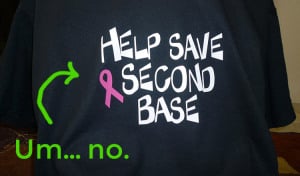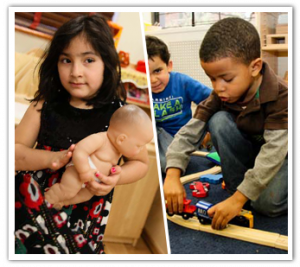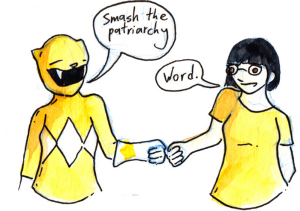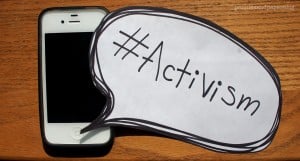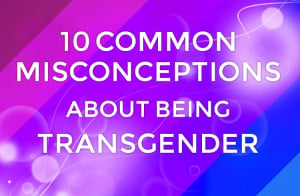
A group of students sit at a table with their teacher, reading and smiling. The photo has a shallow depth of field.
(Content Warning: white supremacist police terror)
Caring for children, even when you’re just trying to do your job in a climate of funding cuts and brutal internal politics, is incredibly demanding and stressful work.
However, if you’re reading this, you’re probably one of the care providers/educators who is already trying, or really wants, to go above and beyond the basic labor of this already challenging role – and you’re probably doing that by taking concrete actions to make your classroom or program a better place for your marginalized students.
Good. The country needs you. Your students need you.
The first step to making change is understanding your own whiteness, and the way white supremacy has impacted our schools.
Start with this excellent article by Jamie Utt about educational pedagogy and the ways white folks engage in white supremacy in the classroom.
It’s clear that we need to be tackling educational policy as a whole, such as advocating for equitable allocation of resources to schools that serve majority children of color and voting down the continual political segregation of districts that forces marginalized children into overwhelmed and underfunded schools.
We also need to combat economic segregation that disproportionately narrows the opportunities children of color have to attend high quality schools and support candidates who understand that holistic “wrap-around” services are the best way to ensure that all children are getting a fair shot at completing their educations.
But in the meantime, here are some things you can do in your school, right now, to make things better for children of color, and to help white children become good allies to their classmates and neighbors of color.
1. Support Teachers of Color
Promote them professionally, recommend them for advancement, pass along compliments to supervisors, and make sure kids see you treat them with respect.
Hire them and consult with them about how to make lesson plans more inclusive. Pay them for this, whether via payroll, or with professional development credits.
I’m the lead teacher of the second and third grade cohort of my program. I give my boss direct, specific, positive feedback on my employees, especially employees that I know, statistically, will be discriminated against professionally. I do this even though management already likes and respect them.
I give this positive feedback both in casual and documentable form, such as e-mails.
Every employee in a program should have a file about their work performance, and the more documented positive feedback is in that file, the greater the chance for promotion, job security, and good treatment.
2. Promote Representation of Children of Color
I do not have a traditional classroom, but I do provide art materials for my students. I search for coloring pages that show positive depictions of people of different races, sizes, and abilities.
I tailor my selections based on student interest. For example, I have a few kids who are into fashion, so I print out pictures of women of color with beautiful hairstyles and dresses.
I choose pictures of girls of color playing sports, boys of color doing “nurturing” activities such as bathing puppies or reading, and princesses of all colors, shapes, and sizes.
Most of the time, the kids grab the pages and move on to the next thing without much of an externalized reaction, but representation matters, and sometimes children give me specific feedback.
One girl, Ayana*, came up to me excitedly holding a picture I’d printed out of a fashionable girl getting ready to shred on a skateboard. “I love this! It reminds me of me!” she exclaimed excitedly.
Another small, but mighty victory I’ve had this year was convincing my director to order the Crayola “multicultural” markers. Euphemistic name aside, these markers offer a much broader selection of skin colors.
I had noticed that the kids were coloring almost all people with yellow or peach skin and hair. I realized that we only had one or two colors that could conceivably look like human skin – of course the kids were choosing colors that wouldn’t obscure facial features!
I got my coworkers on board, then brought the shiny new markers to the kids and explained that before we’d only had one or two colors for skin, which was ridiculous.
During this chat, I also explained that “white” people also have different skin colors. I compared my light olive skin to Selene’s* pinker skin and pointed out that although we are both “white,” our skin isn’t identical.
But now we had so many more, and that I was excited to see the beautiful things they could do with the new options.
Unsurprisingly, our coloring pages suddenly got more diverse.
It is important to introduce white kids to the idea that nothing about Whiteness is as simple as they think it is. We have different skin colors, hair colors, features, and cultural practices.
This is a good introductory lesson to the idea that Whiteness is a political construct used to subjugate people of color by erasing the diversity of all people in favor of a binary system of white-versus-dark, good-versus-bad, and deserving-versus-undeserving.
3. Use a ‘Light Touch’ When Disciplining Students of Color
Aside from the school-to-prison pipeline, research shows that students (especially girls) coping with trauma are often harshly disciplined.
Trauma is equally distributed across race and class, but students of color experience multiple intersections that can complicate or amplify the effects of trauma.
In addition, educators who are not well-versed in cultural competency may misinterpret signs of trauma in children of color as “acting out” or “aggression.”
That’s not to say that white children never face horrible home circumstances. Every day I see children contending with poverty, abuse, and other things that should never happen to anyone, let alone helpless kids.
However, children of color have to deal with these issues plus institutional discrimination.
Children of color are being judged by the same behavior standards as children whose culture, languages, and bodies haven’t been subjugated for hundreds of years.
Many of the behavior standards we have are antithetical to healthy development for all children, but they’re especially ill-suited to children of color, considering the public education system was founded and developed with racism as a basic tenet.
The best way to make sure that discipline is being meted equitably and with sensitivity to the needs of marginalized students is to develop a well-thought out, consistent, documented policy.
Here are some good places to start researching your strategies.
Although this may seem counter-intuitive, an important part of your discipline plan may be refusing to document the “transgressions” of children of color unless they present immediate danger to themselves or another.
It may seem unfair to take this step out of the discipline process for students of color, but research has demonstrated that it is often repeated contact with school authorities that paves the way for youth of color to become disillusioned with the school system, and pushes them into the criminal justice system.
The NAACP reports that “[p]rison has not been proven as a rehabilitation for behavior, as two-thirds of prisoners will offend again.” And even for those children who successfully leave the prison system, “[j]ail reduces work time of young people over the next decade by 25-30% when compared with arrested youths who were not incarcerated.”
Discipline plans should be flexible and evaluate students on a case-by-case basis, but consider a recent study by the National Center for Biotechnology Information of nineteen middle schools in a large Midwestern public school district, which “found that Black youth were referred to the office more often than White youth.”
We are clearly acting with bias.
Additionally, the study found that
the reasons that Black and White youth were sent to the office were different, with Black students being sent to the office for more subjective reasons like “disrespect” and “perceived threat,” while White students were more likely to be referred for more objective reasons that included smoking, vandalism, and leaving school without permission.
So, since we cannot be sure we are acting without bias, and the consequences of frequent and harsh discipline of students of color can be deadly, using a “light touch” can make a remarkable difference in your students’ abilities to succeed, as well as their safety.
(Also, we should learn from the example set by this Baltimore school, which replaced detention with meditation and has seen shocking improvements in student behavior.)
4. Do Your Homework
Read up on best practices for teaching students of color, written by educators of color.
Start with this piece on communicating with students who are not like you.
“The reality,” says the author, Christopher Emdin, “is that we privilege people who look and act like us, and perceive those who don’t as different and, frequently, inferior.”
Another educator explains why sending Black kids to “time outs” with Black teachers instead of taking responsibility for students in your own classroom hurts your relationship with the kids, leading to a negative cycle of mistrust and harsh discipline.
Our job, as the beneficiaries of centuries of institutional privilege, is to believe what educators of color say, and put their practices into place.
I read extensively on educational policy – I began with course reading in college and continued out of curiosity and a desire to develop my professional skills – and I am still surprised by how many Black educators are bringing up essential strategies and practices that I have never heard of before.
So step up. If the institution of education is shutting out certain voices, amplify those voices and bring them back into the conversation.
5. Interrupt Racist Comments
Interrupt them all, regardless of if they come from kids, peers, or supervisors.
A list of organizations with guides to combating racism can be found here, but here’s a sampler of phrases to derail racist comments and jokes (whether they are intentionally offensive or not):
- That’s not funny to me. It’s racist.
- What makes that joke funny?
- I don’t want to put you on the spot, but that comment makes me uncomfortable.
- Think about what you just said. If you really mean that, we need to talk.
- I’m sorry, what?
- Ouch, that hurts.
- It sounds like you’re assuming x – what if we assumed y instead?
- You may not realize this, but you’re talking about my story.
- What you just said does not reflect the good person I know you are.
Bonus: These can also be used to disrupt sexist, ableist, sizeist, and other oppressive comments, too!
Consider practicing saying these things in a mirror or with a friend, since it can feel awkward to respond in an assertive way when we are used to glossing over “controversial” topics.
When you get comfortable, they are excellent tools to encourage critical thinking as well as shut down conversations that may damage the self esteem of your students of color.
6. Develop a Plan to Reduce Racism in Your Classroom
Here are mine for this school year:
- Intervene when kids of color are punished more harshly or frequently.
- Give kids access to diverse media, and encourage them (by leading by example and direct encouragement) to choose the diverse materials.
- Explain the differences between racism and anti-racism using age-appropriate language.
- Model respectful interactions with my co-workers of color.
- Shut down cultural appropriation by other white folks, especially adults.
- Give students of color more positive attention than their white peers to balance out the positive attention gap. (White teachers often have negative attitudes towards Black students that they may or may not be aware of, plus it’s not like white children aren’t generally centered everywhere else.)
- Hire a consultant to talk to our staff about how to help kids stay neat and clean while remaining sensitive to cultural and ethnic differences, especially with regards to Black hair.
- Stand between my students and authorities such as police officers and bus driver outside our program who may trigger trauma in my students of color.
- Empower my students to bring up issues of race and discrimination in a safe environment, and help the white students respond with support and solidarity to the concerns of their peers.
7. Educate Yourself on Intersectional Issues
Race does not exist in a vacuum. Children of different races, ethnicities, and cultural backgrounds have vastly different experiences of oppression.
Professional development opportunities – NYCORE, Free Minds, and other similar conferences – are ideal opportunities to grow your knowledge and network with other educators committed to racial justice and anti-bias education.
However, you don’t need to travel to learn. Here’s an article on how to teach with sensitivity to the experiences of Native children. It’s a good place to start.
Here’s a list of anti-bias resources put together by the Anti-Defamation League.
Read as much as you can, and try focusing on topics relevant to your kids.
***
If you think you can’t make a difference because you have no institutional power – maybe you’re “just” a paraeducator, an afterschool teacher (like me!), a camp counselor, or a daycare worker – think again.
Racial bias is everywhere, and even children in preschool are being negatively impacted by racism.
You are more powerful than you may believe. You can still influence kids without having the authority to develop curricula!
While we fight for systemic changes that will shift the balance of power nationally, we can shift the balance of power in our own microcosms with concrete, actionable steps towards racial justice.
**
[do_widget id=’text-101′]
Wiley Reading is a Contributing Writer at Everyday Feminism. Wiley is a New Jersey-born artist, writer, environmentalist, and social justice advocate located in Burlington, VT. He works as a community health worker for the Greater Burlington YMCA, and writes for Disrupting Dinner Parties, a small collective feminist blog. In his free time, Wiley draws bugs and old buildings, loves every show on the Food Network, makes creative (read: pulled-from-the-recycling) toys for his bunnies, and tipsily reminds every person in every bar that New Jersey is the best state. Follow him on Twitter @wreadinggo.
Search our 3000+ articles!
Read our articles about:
Our online racial justice training
Used by hundreds of universities, non-profits, and businesses.
Click to learn more







